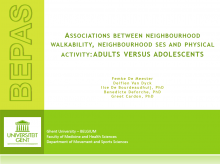We are pleased to announce an exciting new alliance between Active Living Research and GP RED to co-host and coordinate...
Associations between Neighbourhood Walkability, Neighborhood SES and Physical Activity: Adults versus Adolescents

Presentation at the 2011 Active Living Research Annual Conference
Background:
The importance of physical activity (PA) as a health behavior is well documented. A comprehensive understanding of the determinants of PA is therefore a key health priority and crucial for the development of effective interventions. Ecological models hypothesize that there are multiple levels of influencing factors including demographic factors, psychosocial factors and factors of the physical environment. Recently there has been a growing body of evidence documenting the association of environmental attributes with levels of PA in adults. The association of neighbourhood walkability and neighbourhood socio-economic status (SES) with PA represents a particularly important part of this research. In adult research, high-walkable neighbourhoods are often characterized by high street connectivity, residential density and land use mix. To our knowledge no studies have compared yet the association of neighbourhood walkability and SES with PA in adults and adolescents.
Objectives:
The main purpose of this study is to investigate whether neighbourhood walkability as defined using the adult criteria and neighbourhood SES are to the same extent related to levels of PA in an adolescent and adult population. Therefore we compared the association of neighbourhood walkability and SES with levels of PA in adults and adolescents living in the same neighbourhoods.
Methods:
In Ghent (Belgium), 24 neighbourhoods were selected based on walkability and SES. The walkability index used for neighbourhood selection was determined using objective GIS-based measures of residential density, connectivity and land use mix. The neighbourhoods were also matched on neighbourhood SES, derived from neighbourhood median income data. The selection resulted in 6 high-walkable/low-SES neighbourhoods, 6 high-walkable/high-SES neighbourhoods, 6 low-walkable/low-SES neighbourhoods and 6 low-walkable/high-SES neighbourhoods.
From those 24 neighbourhoods 478 adolescents (aged 13 to 15) and 1166 adults (aged 20 to 65) participated in the study. The PA levels of the participants were assessed using the Flemish Physical Activity Questionnaire for adolescents and the long International Physical Activity Questionnaire (last seven days interview version) for adults. Furthermore, all participants were asked to wear an accelerometer for 7 consecutive days.
To analyze the moderating effect of age (adolescent-adult) on the association of neighbourhood walkability and SES with PA, multivariate regression analyses were conducted using MLwin version 2.02. To take the clustering of participants within the neighbourhoods into account, multi-level modeling (two levels: participant-neighbourhood) was applied. All models were adjusted for socio-demographic confounders.
Results:
The multi-level models revealed that the association of neighbourhood walkability with self-reported min./week active transport was moderated by age (p<0.001). Adults living in high-walkable neighbourhoods reported 117 min./week (p<0.001) more active transport than adults living in low-walkable neighbourhoods. In adolescents, the self-reported min./week active transport did not significantly differ according to neighbourhood walkability. Age did not moderate the association of neighbourhood walkability with accelerometer-based moderate to vigorous physical activity (MVPA) and self-reported min./week sport during leisure time and total PA. Living in high-walkable neighbourhoods was associated with more accelerometer-based MVPA (p<0.001) and with more self-reported min./week total PA (p<0.05). For the self-reported number of min./week sport during leisure time no association was found with neighbourhood walkability for the total sample.
For the association of neighbourhood SES with accelerometer-based MVPA, age also acts as a moderator (p<0.01). In adolescents, neighbourhood SES showed an independent association with accelerometer-based MVPA (p<0.01). Adolescents living in low-SES neighbourhoods performed 42 min./week more MVPA than adolescents living in high-SES neighbourhoods. In adults, the accelerometer-based MVPA did not significantly differ according to neighbourhood SES. Age did not moderate the association of neighbourhood SES with self-reported min./week active transport, sport during leisure time and total PA. Living in high-SES neighbourhoods was associated with more min./week active transport (p<0.01) and with less min./week sport during leisure time (p<0.001). For the total number of min./week PA no association was found with neighbourhood SES for the total sample.
Conclusions:
These findings indicate that the association of neighbourhood walkability and SES with PA is not totally comparable between adults and adolescents. The association of neighbourhood walkability with self-reported active transport differed between adults and adolescents. A high walkable neighbourhood as defined using the adult criteria, is a trigger for more active transport in the adult population, but it is not to the same extent related to higher levels of active transport in adolescents. Furthermore, the association of neighbourhood SES with accelerometer-based MVPA differed also between adults and adolescents. In the adolescent population neighbourhood SES was to a higher extent a determining factor of higher levels MVPA.
The discrepancies in the association of neighbourhood walkability and SES with PA between adults and adolescents must be considered in the selection of the appropriate key elements for PA interventions to reach both age groups. However, there is an urgent need to further investigate the differences in the association of neighbourhood walkability and SES with the levels of PA between adults and adolescents.
Support:
This study was supported by a research grant from Ghent University.
STAY UP TO DATE
RECENTLY ADDED TOOLS & RESOURCES
MOVE! A BLOG ABOUT ACTIVE LIVING
The "Active Living Conference" aims to break down research and practice silos and...







